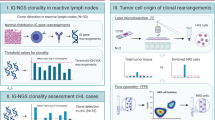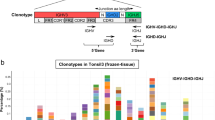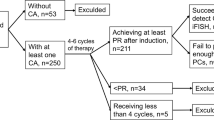Abstract
The hypervariable regions of immunoglobulin heavy-chain (IgH) rearrangements provide a specific tumor marker in multiple myeloma (MM). Recently, real-time PCR assays have been developed in order to quantify the number of tumor cells after treatment. However, these strategies are hampered by the presence of somatic hypermutation (SH) in VDJH rearrangements from multiple myeloma (MM) patients, which causes mismatches between primers and/or probes and the target, leading to a nonaccurate quantification of tumor cells. Our group has recently described a 60% incidence of incomplete DJH rearrangements in MM patients, with no or very low rates of SH. In this study, we compare the efficiency of a real-time PCR approach for the analysis of both complete and incomplete IgH rearrangements in eight MM patients using only three JH consensus probes. We were able to design an allele-specific oligonucleotide for both the complete and incomplete rearrangement in all patients. DJH rearrangements fulfilled the criteria of effectiveness for real-time PCR in all samples (ie no unspecific amplification, detection of less than 10 tumor cells within 105 polyclonal background and correlation coefficients of standard curves higher than 0.98). By contrast, only three out of eight VDJH rearrangements fulfilled these criteria. Further analyses showed that the remaining five VDJH rearrangements carried three or more somatic mutations in the probe and primer sites, leading to a dramatic decrease in the melting temperature. These results support the use of incomplete DJH rearrangements instead of complete somatically mutated VDJH rearrangements for investigation of minimal residual disease in multiple myeloma.
This is a preview of subscription content, access via your institution
Access options
Subscribe to this journal
Receive 12 print issues and online access
$259.00 per year
only $21.58 per issue
Buy this article
- Purchase on Springer Link
- Instant access to full article PDF
Prices may be subject to local taxes which are calculated during checkout


Similar content being viewed by others
References
Vescio RA, Cao J, Hong CH, Lee JC, Wu CH, Der DM et al. Myeloma Ig heavy chain V region sequences reveal prior antigenic selection and marked somatic mutation but no intraclonal diversity. J Immunol 1995; 155: 2487–2497.
Kosmas C, Stamatopoulos K, Stavroyianni N, Zoi K, Belessi C, Viniou N et al. Origin and diversification of the clonogenic cell in multiple myeloma: lessons from the immunoglobulin repertoire. Leukemia 2000; 14: 1718–1726.
Pilarski LM, Masellis S, Szczepek A, Mant MJ, Belch AR . Circulating clonotypic B cells in the biology of multiple myeloma: speculations on the origin of myeloma. Leukemia Lymphoma 1996; 22: 375–383.
Bakkus MH, Heirman C, van Riet I, van Camp B, Thielemans K . Evidence that multiple myeloma Ig heavy chain VDJ genes contain somatic mutations but show no intraclonal variation. Blood 1992; 80: 2326–2335.
Fermand JP, Ravaud P, Chevret S, Divine M, Leblond V, Belanger C et al. High-dose therapy and autologous peripheral blood stem cell transplantation in multiple myeloma: up-front or rescue treatment? Results of a multicenter sequential randomized clinical trial. Blood 1998; 92: 3131–3136.
Dreyfus F, Ribrag V, Leblond V, Ravaud P, Melle J, Quarre MC et al. Detection of malignant B cells in peripheral blood stem cell collections after chemotherapy in patients with multiple myeloma. Bone Marrow Transplant 1995; 15: 707–711.
Corradini P, Voena C, Astolfi M, Ladetto M, Tarella C, Boccadoro M et al. High-dose sequential chemoradiotherapy in multiple myeloma: residual tumor cells are detectable in bone marrow and peripheral blood cell harvests and after autografting. Blood 1995; 85: 1596–1602.
Barlogie B, Jagannath S, Desikan KR, Mattox S, Vesole D, Siegel D et al. Total therapy with tandem transplants for newly diagnosed multiple myeloma. Blood 1999; 93: 55–65.
Corradini P, Voena C, Tarella C, Astolfi M, Ladetto M, Palumbo A et al. Molecular and clinical remissions in multiple myeloma: role of autologous and allogeneic transplantation of hematopoietic cells. J Clin Oncol 1999; 17: 208–215.
Lopez-Perez R, Garcia-Sanz R, Gonzalez D, Balanzategui A, Chillon MC, Alaejos I et al. The detection of contaminating clonal cells in apheresis products is related to response and outcome in multiple myeloma undergoing autologous peripheral blood stem cell transplantation. Leukemia 2000; 14: 1493–1499.
Bergsagel PL, Smith AM, Szczepek A, Mant MJ, Belch AR, Pilarski LM . In multiple myeloma, clonotypic B lymphocytes are detectable among CD19+ peripheral blood cells expressing CD38, CD56, and monotypic Ig light chain. Blood 1995; 85: 436–447.
Vescio RA, Han EJ, Schiller GJ, Lee JC, Wu CH, Cao J et al. Quantitative comparison of multiple myeloma tumor contamination in bone marrow harvest and leukapheresis autografts. Bone Marrow Transplant 1996; 18: 103–110.
Billadeau D, Quam L, Thomas W, Kay N, Greipp P, Kyle R et al. Detection and quantitation of malignant cells in the peripheral blood of multiple myeloma patients. Blood 1992; 80: 1818–1824.
Ladetto M, Donovan JW, Harig S, Trojan A, Poor C, Schlossnan R et al. Real-Time polymerase chain reaction of immunoglobulin rearrangements for quantitative evaluation of minimal residual disease in multiple myeloma. Biol Blood Marrow Transplant 2000; 6: 241–253.
Gerard CJ, Olsson K, Ramanathan R, Reading C, Hanania EG . Improved quantitation of minimal residual disease in multiple myeloma using real-time polymerase chain reaction and plasmid-DNA complementarity determining region III standards. Cancer Res 1998; 58: 3957–3964.
Rasmussen T, Poulsen TS, Honore L, Johnsen HE . Quantitation of minimal residual disease in multiple myeloma using an allele-specific real-time PCR assay. Exp Hematol 2000; 28: 1039–1045.
Bruggemann M, Droese J, Bolz I, Luth P, Pott C, von Neuhoff N et al. Improved assessment of minimal residual disease in B cell malignancies using fluorogenic consensus probes for real-time quantitative PCR. Leukemia 2000; 14: 1419–1425.
Pongers-Willemse MJ, Verhagen OJ, Tibbe GJ, Wijkhuijs AJ, de Haas V, Roovers E et al. Real-time quantitative PCR for the detection of minimal residual disease in acute lymphoblastic leukemia using junctional region specific TaqMan probes. Leukemia 1998; 12: 2006–2014.
Garcia-Sanz R, Lopez-Perez R, Langerak AW, Gonzalez D, Chillon MC, Balanzategui A et al. Heteroduplex PCR analysis of rearranged immunoglobulin genes for clonality assessment in multiple myeloma. Haematologica 1999; 84: 328–335.
Verhagen OJ, Willemse MJ, Breunis WB, Wijkhuijs AJ, Jacobs DC, Joosten SA et al. Application of germline IGH probes in real-time quantitative PCR for the detection of minimal residual disease in acute lymphoblastic leukemia. Leukemia 2000; 14: 1426–1435.
Gonzalez M, Gonzalez D, Lopez-Perez R, Garcia-Sanz R, Chillon MC, Balanzategui A et al. Heteroduplex analysis of VDJ amplified segments from rearranged IgH genes for clonality assessments in B-cell non-Hodgkin's lymphoma. A comparison between different strategies. Haematologica 1999; 84: 779–784.
Cook GP, Tomlinson IM . The human immunoglobulin VH repertoire. Immunol Today 1995; 16: 237–242.
Lefranc MP . IMGT, the international ImMunoGeneTics database. Nucleic Acids Res 2001; 29: 207–209.
Schutz E, von A . Spreadsheet software for thermodynamic melting point prediction of oligonucleotide hybridization with and without mismatches. Biotechniques 1999; 27: 1218–1222, 1224.
Schiller G, Vescio R, Freytes C, Spitzer G, Sahebi F, Lee M et al. Transplantation of CD34+ peripheral blood progenitor cells after high-dose chemotherapy for patients with advanced multiple myeloma. Blood 1995; 86: 390–397.
Henry JM, Sykes PJ, Brisco MJ, To LB, Juttner CA, Morley AA . Comparison of myeloma cell contamination of bone marrow and peripheral blood stem cell harvests. Br J Haematol 1996; 92: 614–619.
Drunat S, Olivi M, Brunie G, Grandchamp B, Vilmer E, Bieche I et al. Quantification of TEL-AML1 transcript for minimal residual disease assessment in childhood acute lymphoblastic leukaemia. Br J Haematol 2001; 114: 281–289.
Marcucci G, Caligiuri MA, Dohner H, Archer KJ, Schlenk RF, Dohner K et al. Quantification of CBFbeta/MYH11 fusion transcript by real time RT-PCR in patients with INV(16) acute myeloid leukemia. Leukemia 2001; 15: 1072–1080.
Cassinat B, Zassadowski F, Balitrand N, Barbey C, Rain JD, Fenaux P et al. Quantitation of minimal residual disease in acute promyelocytic leukemia patients with t(15;17) translocation using real-time RT-PCR. Leukemia 2000; 14: 324–328.
Wattjes MP, Krauter J, Nagel S, Heidenreich O, Ganser A, Heil G . Comparison of nested competitive RT-PCR and real-time RT-PCR for the detection and quantification of AML1/MTG8 fusion transcripts in t(8;21) positive acute myelogenous leukemia. Leukemia 2000; 14: 329–335.
Pfitzner T, Engert A, Wittor H, Schinkothe T, Oberhauser F, Schulz H et al. A real-time PCR assay for the quantification of residual malignant cells in B cell chronic lymphatic leukemia. Leukemia 2000; 14: 754–766.
Acknowledgements
This work was partially supported by the BIOMED-2 Concerted Action (BMH4-CT98-3936). David González is supported by the ‘Instituto de Salud Carlos III’ (BISCIII) Grant 99/4230.
Author information
Authors and Affiliations
Rights and permissions
About this article
Cite this article
González, D., González, M., Alonso, M. et al. Incomplete DJH rearrangements as a novel tumor target for minimal residual disease quantitation in multiple myeloma using real-time PCR. Leukemia 17, 1051–1057 (2003). https://doi.org/10.1038/sj.leu.2402937
Received:
Accepted:
Published:
Issue Date:
DOI: https://doi.org/10.1038/sj.leu.2402937
Keywords
This article is cited by
-
High applicability of ASO-RQPCR for detection of minimal residual disease in multiple myeloma by entirely patient-specific primers/probes
Journal of Hematology & Oncology (2016)
-
Detection of monoclonal IGH rearrangements in circulating cells from healthy first-degree relatives of patients with multiple myeloma
Medical Oncology (2014)
-
Critical evaluation of ASO RQ-PCR for minimal residual disease evaluation in multiple myeloma. A comparative analysis with flow cytometry
Leukemia (2014)
-
Significantly improved PCR-based clonality testing in B-cell malignancies by use of multiple immunoglobulin gene targets. Report of the BIOMED-2 Concerted Action BHM4-CT98-3936
Leukemia (2007)



